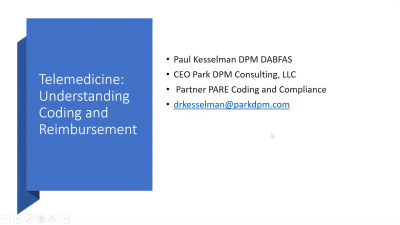
Practice Perfect 805
The Most Challenging Side of Podiatry:
Managed Care
The Most Challenging Side of Podiatry:
Managed Care

Taking care of patients with lower extremity complaints is quite challenging and already very complex. We need to have a thorough knowledge of many medical, scientific, and psychological topics. Podiatrists additionally perform many different types of technical procedures. All of this is done on our very complicated patients with their myriad issues.
However, the one issue that makes the practice of podiatry even more complex is managed care. For some in the United States, the challenges of managed patient insurance might not be too prominent, but in my neck of the medical woods in California, managed care is a major component of private practice. As a quick description to define this discussion, managed care organizations are insurance companies tasked with reducing costs while providing patients medical care by contracting with physicians and medical groups to provide that care. As we know, the United States does not have a comprehensive national healthcare service, so patients have private insurance (such as a health maintenance organization, preferred provider organization, etc), or government insurance like Medicaid, Medicare (for those 65 years and older and those disabled), or no insurance. Let’s focus on the private insurances.
The one issue that makes the practice of podiatry even more complex is managed care.
The Dreaded Prior Authorization
The primary issue I have with managed care is the need for authorizations. For those of you new to the profession or in a less managed area, certain insurance companies require physicians to request approval for services such as procedures, durable medical equipment, and office visits in order for them to pay for said service. Someone at the insurance company either approves or declines the request based on the company’s protocols.
Painful Examples
Let me give a quick example. A patient with a bunion deformity presents with an authorization for an office visit. After examining the patient, the podiatrist has to request an authorization for radiographs, which will likely occur at a separate visit. If they then decide to do surgery or treat with foot orthosis therapy, they will have to request yet another authorization. This will create three different office visits, each with additional costs, where all of this could have been done in one office visit.
It is easy to imagine where some complaints might arise. First, from a convenience and quality of care standpoint, the necessity to obtain approval delays care and is highly inconvenient for patients.
As another example, a new patient presents with an ingrown toenail diagnosis with coverage by a certain HMO insurance company. They present with an “auth” for an evaluation and management code (essentially the office visit) but not a nail procedure code. I then have the choice to either have the patient return for a second visit after the authorization has been approved or do the procedure on the same day, risking nonpayment or billing the patient. Sending the patient away for a later return is obviously not a best practice in this situation, nor is it convenient.
This system also forces physicians to become billing and coding experts – clearly not something any of us wanted when we applied for medical school. For example, when requesting an authorization for custom functional foot orthoses, one must know the code (L3000). But wait, it’s not just L3000. That’s the number for a single orthosis. We must actually request L3000 x 2. Want to request authorization for radiographs? Ankle or foot? Bilateral or unilateral? How many views? 73630, 73620, 73610 are just a couple of the coding options. This goes on and on for hundreds if not thousands of codes.
But There’s More…
But that’s still not all! For many insurance companies, they will only authorize certain codes based on specific diagnoses. That means we have to become experts in ICD-10 diagnosis coding. As a simple example, Medicare will not pay for custom foot orthoses unless the patient has diabetes. Similarly, other insurance companies may cover night splints but not orthoses for plantar fasciitis. There is a list of approved diagnoses and services for which they will pay doctors, and we have to know each individual company’s preferences.
As a painful example of this, I recently received a communication from my practice’s authorization person educating me on which diagnostic codes to use to receive an approved authorization for foot orthoses from one of our insurance companies. These codes ranged from diabetes to various neurological disorders such as amyotrophic lateral sclerosis to hallux valgus. If you’re a patient with this particular insurance, and you suffer from pronatory foot disorders without one of these diagnoses, then you’re out of luck. These lists of approved codes vary with each company, requiring us to either memorize lists of codes or keep them on hand as a reference.
I find this aspect distasteful. First, I refuse to memorize lists of codes like this. I have other things to do. Second, and more importantly, physicians are not supposed to fit our diagnoses to the codes. The diagnosis is what it is regardless of what some insurance company wants. I become an angry and belligerent person whenever my biller asks me to review my coding to find a “better” code.
Physicians are not supposed to fit our diagnoses to the codes, but we are so often forced to find a “better” code.
Obviously, this is a much more expensive process. Both of the practices in which I work must hire extra staff just to handle the administrative aspects of these insurances. Patients must return repeatedly for care that could have been done in one visit. And insurance companies themselves run at higher operating costs. Personally, my favorite insurance is Medicare plus a supplemental insurance because it does not require prior authorizations (for the most part) and it makes clear what services it does and does not cover.
Personally, my favorite insurance is Medicare as it generally does not require prior authorizations.
The other part of this issue is that very specific wording in our charts is also necessary to “justify” treatment. For example, wound debridements require us to use words such as “excisional”, “nonexcisional”, “selective” and “nonselective.” Without proper wording, a doctor receiving an audit may end up having to pay back money previously paid to them. Clearly, a nightmare scenario and a risky aspect of practicing medicine.
So, how can the young podiatrist about to go into practice deal with this state of affairs?
- Suck it up - Understand that this is the reality in many locales in the United States. Acceptance will lead to less anxiety.
- Don’t want to suck it up? Get a job with a closed healthcare system such as Kaiser Permanente or the VA system - These systems are much less concerned with coding and billing, keeping in mind that there are other prices to pay to maintain cost controls.
- Podiatric residencies should teach this to our residents - Residency is a great time to build coding, billing, and practice management experience over a longer (thus less painful) time period. If your residency doesn’t teach this, then ask to shadow one of your attendings in their office with the goal to learn about coding.
- Attend a conference - For example, the American College of Foot and Ankle Surgeons has a surgical coding conference, and the PRESENT Treasure Hunt Conference has excellent coding updates every year.
- Purchase any of the quality written resources on coding - The American College of Podiatric Medicine sponsors an excellent billing and coding manual.
- Build relationships with your insurance companies whenever possible - Maybe you will be given the opportunity to affect their policies. For example, I was able to help one of my local insurance companies to create a preauthorization program for certain commonly treated foot conditions to improve efficiencies.
Clearly, this has to be the least intellectually rewarding aspect of modern podiatric practice for most of us, and it’s not likely to disappear anytime soon. Become as educated as you can in the process and remember that you’re not alone. Welcome to private practice!
Best wishes.

Jarrod Shapiro, DPM
PRESENT Practice Perfect Editor
[email protected]

































Comments
There are 0 comments for this article